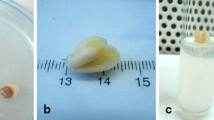Abstract
The in vitro germination of excised embryos can break dormancy rapidly and shorten the time required to produce seedlings, speeding up olive breeding programmes as well as rootstock production. In this study, the in vitro germination potential of four Sicilian olive cultivars was evaluated during two years of experiments, using explants with three different morphological configurations that represent three different degrees of embryo exposure: (1) intact stoneless seeds containing the embryo, the endosperm and the seed coat (Emb+En+SC), (2) seeds without the seed coat (Emb+En) and (3) naked, isolated embryos (seed coat and endosperm both removed: Emb). Differences were found in the germination percentages and timing due to both genotype and explant type. The root and shoot meristems, the radicle-hypocotyl axis, the provascular tissues and embryo storage reserves were identified as embryo anatomical structures which could influence germination capacity. Observation of these structures, however, indicated similar germination potential among cultivars, suggesting possible differences in other dormancy factors. In spite of variation in cultivar performance, after 60 days of in vitro culture all cultivars demonstrated the highest germination of naked embryos (explant type 3) and lowest for stoneless seeds (explant type 1); stoneless seeds without the seedcoat (explant type 2) showed intermediate germination percentages.






Similar content being viewed by others
Abbreviations
- Emb:
-
Naked embryos
- Emb+En:
-
Embryos with seed coat removed but endosperm present
- Emb+En+SC:
-
Intact seeds without the sclerified endocarp
- TA-IC-SAF-FG:
-
Tannic acid, iron chloride, safranin and fast green
- PAS-FG:
-
Periodic acid and Schiff’s with fast green counter-stain
References
Acebedo MM, Lavee S, Linan J, Troncoso A (1997) In vitro germination of embryos for speeding up seedling development in olive breeding programmes. Sci Hortic 69(3–4):207–215
Alché JD, Jimenez-Lopez JC, Wang W, Castro-Lopez AJ, Rodriguez-Garcia MI (2006) Biochemical characterization and cellular localization of 11s type storage proteins in olive (Olea europaea L.) seeds. J Agric Food Chem 54:5562–5570
Berlyn GP, Miksche JP (1976) Botanical microtechnique and cytochemistry. Iowa State University Press, Ames
Cañas LA, Carramolino L, Vicente M (1987) Vegetative propagation of the olive tree from in vitro cultured embryos. Plant Sci 50:85–90
Chen SY, Chien CT, Chung JD, Yang YS, Kuo SR (2007) Dormancy-break and germination in seeds of Prunus campanulata (Rosaceae): role of covering layers and changes in concentration of abscisic acid and gibberellins. Seed Sci Res 17:21–32
Crisosto CH, Sutter EG (1985) Role of the endocarp in ‘Manzanillo’ olive seed germination. J Am Soc Hortic Sci 110:50–52
D’Angeli S, Falasca G, Matteucci M, Altamura MM (2013) Cold perception and gene expression differ in Olea europaea seed coat and embryo during drupe cold acclimation. New Phytol 197:123–138
Fontanazza G, Baldoni L (1990) Proposed programme for genetic improvement of the olive. Olivae 34:32–40
Foster AS (1934) The use of tannic acid and iron chloride for staining cell walls in meristematic tissue. Stain Tech 34:91–92
Germanà MA, Pensabene Bellavia G (2003) Germinazione in vitro di semi di cultivar di olivo siciliane. Italus Hortus 10(4):197–202
Germanà MA, Patricolo G, Chiancone B (2009) In vitro germination of stoneless and isolated embryos of 14 Sicilian cultivars of Olea europaea L. In: Hanke MV, Dunemann F, Flachowsky H (eds) Acta Hortic 839(1):173–179
Girardi EA, Filho FM, Kluge RA (2007) Effect of seed coat removal and controlled-release fertilizer application on plant emergence and vegetative growth of two citrus rootstocks. Fruits 62:13–19
Hartmann H, Kester DE (2002) Plant Propagation. In: Hartmann H, Kester DE, Davies FT Jr, Geneve RL (eds) Principles and practices, p 880
Lagarda A, Martin GC, Kester DE (1983) Influence of environment seed tissue and seed maturity on “Manzanillo” olive seed germination. Hortic Sci 18:868–869
Lloyd G, McCown B (1980) Commercially feasible micropropagation of mountain laurel, Kalmia latifolia, by use of shoot-tip culture. Comb Proc Int Plant Prop Soc 30:421–427
Morales-Sillero A, Suárez MP, Jiménez MR, Casanova L, Ordovás J, Rallo P (2012) Olive seed germination and initial seedling vigor as influenced by stratification treatment and the female parent. HortScience 47:1672–1678
Murashige T, Skoog F (1962) A revised medium for rapid growth and bio-assays with tobacco tissue cultures. Phys Plant 15:473–497
Perán-Quesada R, Sánchez-Romero C, Pliego-Alfaro F, Barceló-Muñoz A (2005) Histological aspects of avocado embryo development and effect of developmental stages on germination. Seed Science Res 15:125–132
Pollacci P, Mencuccini M (2004) Coltura in vitro di embrioni di olivo. Atti delle VII giornate scientifiche SOI, p 437
Ruzin S (1999) Plant microtechnique and microscopy. Oxford University Press, New York, p 322
Scaramuzzi F, Baldini B (1963) Olive da tavola. Edizione Agricole, Bologna
Sotomayor-León EM, Caballero JM (1990) An easy method of breaking olive stone to remove mechanical dormancy. Acta Hortic 286:113–116
Zienkiewicz A, Jiménez-López J, Zienkiewicz K, de Dios Alché J, Rodríguez-García M (2011) Development of the cotyledon cells during olive (Olea europaea L.) in vitro seed germination and seedling growth. Protoplasma 248:751–765
Acknowledgments
This work was partially supported by the CORI (International Cooperation) 2006 program and by the project “Innovative Methods of propagation and Conservation of Mediterranean Trees”, FFR 2012–2013, provided by the University of Palermo to Maria Antonietta Germanà. The authors wish to thank Ester García-Cuevas of IAS-CSIC for excellent technical assistance.
Author information
Authors and Affiliations
Corresponding author
Rights and permissions
About this article
Cite this article
Germanà, M.A., Chiancone, B., Hammami, S.B.M. et al. Olive embryo in vitro germination potential: role of explant configuration and embryo structure among cultivars. Plant Cell Tiss Organ Cult 118, 409–417 (2014). https://doi.org/10.1007/s11240-014-0493-5
Received:
Accepted:
Published:
Issue Date:
DOI: https://doi.org/10.1007/s11240-014-0493-5




